An Ultra-Thin Composite Metasurface with Hybrid-Damping Modes for Broadband Sound Absorption
Abstract
1. Introduction
2. Broadband Absorption of the Composite Metasurface
3. Compound HR Structure with Hybrid-Damping Modes
3.1. Structure of the Broadband Unit and Cell
3.2. Calculation of Sound Absorption Coefficient
3.2.1. Theoretical Calculation
3.2.2. Finite Element Simulation
3.3. Broadband Absorption of Hybrid-Damping Unit
4. Band Expansion through Porous Materials
4.1. Porous Materials Arranged in Parallel
4.2. Porous Materials Arranged in Series
5. Experiment Validation
6. Conclusions
Author Contributions
Funding
Institutional Review Board Statement
Informed Consent Statement
Data Availability Statement
Conflicts of Interest
References
- Arenas, J.P.; Crocker, M.J. Recent Trends in Porous Sound-Absorbing Materials. Sound Vib. 2010, 44, 12–18. [Google Scholar]
- Cao, L.; Fu, Q.; Si, Y.; Ding, B.; Yu, J. Porous Materials for Sound Absorption. Compos. Commun. 2018, 10, 25–35. [Google Scholar] [CrossRef]
- Assouar, B.; Liang, B.; Wu, Y.; Li, Y.; Cheng, J.C.; Jing, Y. Acoustic Metasurfaces. Nat. Rev. Mater. 2018, 3, 460–472. [Google Scholar] [CrossRef]
- Yang, M.; Sheng, P. Sound Absorption Structures: From Porous Media to Acoustic Metamaterials. Annu. Rev. Mater. Res. 2017, 47, 83–114. [Google Scholar] [CrossRef]
- Palma, G.; Mao, H.; Burghignoli, L.; Göransson, P.; Iemma, U. Acoustic Metamaterials in Aeronautics. Appl. Sci. 2018, 8, 971. [Google Scholar] [CrossRef]
- Mei, J.; Ma, G.; Yang, M.; Yang, Z.; Wen, W.; Sheng, P. Dark Acoustic Metamaterials as Super Absorbers for Low-Frequency Sound. Nat. Commun. 2012, 3, 756–757. [Google Scholar] [CrossRef] [PubMed]
- Li, J.; Wang, W.; Xie, Y.; Popa, B.I.; Cummer, S.A. A Sound Absorbing Metasurface with Coupled Resonators. Appl. Phys. Lett. 2016, 109, 091908. [Google Scholar] [CrossRef]
- Lee, T.; Iizuka, H. Heavily Overdamped Resonance Structurally Engineered in a Grating Metasurface for Ultra-Broadband Acoustic Absorption. Appl. Phys. Lett. 2018, 113, 101903. [Google Scholar] [CrossRef]
- Li, Y.; Assouar, B.M. Acoustic Metasurface-Based Perfect Absorber with Deep Subwavelength Thickness. Appl. Phys. Lett. 2016, 108, 063502. [Google Scholar] [CrossRef]
- Zhou, J.; Zhang, X.; Fang, Y. Three-Dimensional Acoustic Characteristic Study of Porous Metasurface. Compos. Struct. 2017, 176, 1005–1012. [Google Scholar] [CrossRef]
- Ma, F.; Wang, C.; Du, Y.; Zhu, Z.; Wu, J.H. Enhancing of Broadband Sound Absorption through Soft Matter. Mater. Horizons 2022, 9, 653–662. [Google Scholar] [CrossRef] [PubMed]
- Jiménez, N.; Huang, W.; Romero-García, V.; Pagneux, V.; Groby, J.P. Ultra-Thin Metamaterial for Perfect and Quasi-Omnidirectional Sound Absorption. Appl. Phys. Lett. 2016, 109, 121902. [Google Scholar] [CrossRef]
- Kumar, S.; Lee, H.P. Labyrinthine Acoustic Metastructures Enabling Broadband Sound Absorption and Ventilation. Appl. Phys. Lett. 2020, 116, 134103. [Google Scholar] [CrossRef]
- Dupont, T.; Leclaire, P.; Panneton, R.; Umnova, O. A Microstructure Material Design for Low Frequency Sound Absorption. Appl. Acoust. 2018, 136, 86–93. [Google Scholar] [CrossRef]
- Mahesh, K.; Kumar Ranjith, S.; Mini, R.S. Inverse Design of a Helmholtz Resonator Based Low-Frequency Acoustic Absorber Using Deep Neural Network. J. Appl. Phys. 2021, 129, 174901. [Google Scholar] [CrossRef]
- Huang, S.; Zhou, Z.; Li, D.; Liu, T.; Wang, X.; Zhu, J.; Li, Y. Compact Broadband Acoustic Sink with Coherently Coupled Weak. Sci. Bull. 2019, 65, 373–379. [Google Scholar] [CrossRef]
- Liu, C.R.; Wu, J.H.; Yang, Z.; Ma, F. Ultra-Broadband Acoustic Absorption of a Thin Microperforated Panel Metamaterial with Multi-Order Resonance. Compos. Struct. 2020, 246, 112366. [Google Scholar] [CrossRef]
- Jiménez, N.; Romero-García, V.; Pagneux, V.; Groby, J.P. Rainbow-Trapping Absorbers: Broadband, Perfect and Asymmetric Sound Absorption by Subwavelength Panels for Transmission Problems. Sci. Rep. 2017, 7, 13595. [Google Scholar] [CrossRef] [PubMed]
- Peng, X.; Ji, J.; Jing, Y. Composite Honeycomb Metasurface Panel for Broadband Sound Absorption. J. Acoust. Soc. Am. 2018, 144, EL255–EL261. [Google Scholar] [CrossRef]
- Liu, C.R.; Wu, J.H.; Chen, X.; Ma, F. A Thin Low-Frequency Broadband Metasurface with Multi-Order Sound Absorption. J. Phys. D Appl. Phys. 2019, 52, 105302. [Google Scholar] [CrossRef]
- Liu, Y.; Ren, S.; Sun, W.; Lei, Y.; Wang, H.; Zeng, X. Broadband Low-Frequency Sound Absorbing Metastructures Based on Impedance Matching Coiled-up Cavity. Appl. Phys. Lett. 2021, 119, 101901. [Google Scholar] [CrossRef]
- Ryoo, H.; Jeon, W. Broadband Sound Absorption Using Multiple Hybrid Resonances of Acoustic Metasurfaces. Int. J. Mech. Sci. 2022, 229, 107508. [Google Scholar] [CrossRef]
- Liu, C.; Yang, Z.; Liu, X.; Wu, J.H.; Ma, F. Ultra-Broadband Acoustic Absorption with Inhomogeneous High-Order Fabry-Pérot Resonances. APL Mater. 2023, 11, 101122. [Google Scholar] [CrossRef]
- Shao, C.; Zhu, Y.; Long, H.; Liu, C.; Cheng, Y.; Liu, X. Metasurface Absorber for Ultra-Broadband Sound via over-Damped Modes Coupling. Appl. Phys. Lett. 2022, 120, 083504. [Google Scholar] [CrossRef]
- Mei, Z.; Li, X.; Lyu, Y.; Sang, J.; Cheng, X.; Yang, J. Broadband Sound Absorption Based on Impedance Decoupling and Modulation Mechanisms. J. Acoust. Soc. Am. 2023, 154, 3479–3486. [Google Scholar] [CrossRef]
- Zhou, Z.; Huang, S.; Li, D.; Zhu, J.; Li, Y. Broadband Impedance Modulation via Non-Local Acoustic Metamaterials. Natl. Sci. Rev. 2022, 9, nwab171. [Google Scholar] [CrossRef]
- Yang, J.; Lee, J.S.; Kim, Y.Y. Multiple Slow Waves in Metaporous Layers for Broadband Sound Absorption. J. Phys. D Appl. Phys. 2017, 50, 015301. [Google Scholar] [CrossRef]
- Zhu, X.F.; Lau, S.K.; Lu, Z.; Jeon, W. Broadband Low-Frequency Sound Absorption by Periodic Metamaterial Resonators Embedded in a Porous Layer. J. Sound Vib. 2019, 461, 114922. [Google Scholar] [CrossRef]
- Yuan, T.; Song, X.; Xu, J.; Pan, B.; Sui, D.; Xiao, H.; Zhou, J. Tunable Acoustic Composite Metasurface Based Porous Material for Broadband Sound Absorption. Compos. Struct. 2022, 298, 116014. [Google Scholar] [CrossRef]
- Zhao, H.; Wang, Y.; Yu, D.; Yang, H.; Zhong, J.; Wu, F.; Wen, J. A Double Porosity Material for Low Frequency Sound Absorption. Compos. Struct. 2020, 239, 111978. [Google Scholar] [CrossRef]
- Li, Y.; Lin, Y.; Yao, S.; Shi, C. Low-Frequency Broadband Sound Absorption of the Metastructure with Extended Tube Resonators and Porous Materials. Appl. Acoust. 2024, 217, 109827. [Google Scholar] [CrossRef]
- Yang, M.; Chen, S.; Fu, C.; Sheng, P. Optimal Sound-Absorbing Structures. Mater. Horizons 2017, 4, 673–680. [Google Scholar] [CrossRef]
- Long, H.; Shao, C.; Liu, C.; Cheng, Y.; Liu, X. Broadband Near-Perfect Absorption of Low-Frequency Sound by Subwavelength Metasurface. Appl. Phys. Lett. 2019, 115, 1–12. [Google Scholar] [CrossRef]
- Xie, S.; Li, Z.; Yan, H.; Yang, S. Ultra-Broadband Sound Absorption Performance of a Multi-Cavity Composite Structure Filled with Polyurethane. Appl. Acoust. 2022, 189, 108612. [Google Scholar] [CrossRef]
- Yan, J.; Li, Y.; Peng, Y.; Yao, S. Acoustic Metasurface Embedded with Thin-Walled Plate Based on Phase Modulation for Multi-Angle Broadband Sound Absorption. Thin-Walled Struct. 2024, 199, 111839. [Google Scholar] [CrossRef]
- Cheng, B.; Gao, N.; Huang, Y.; Hou, H. Broadening Perfect Sound Absorption by Composite Absorber Filled with Porous Material at Low Frequency. J. Vib. Control 2022, 28, 410–424. [Google Scholar] [CrossRef]
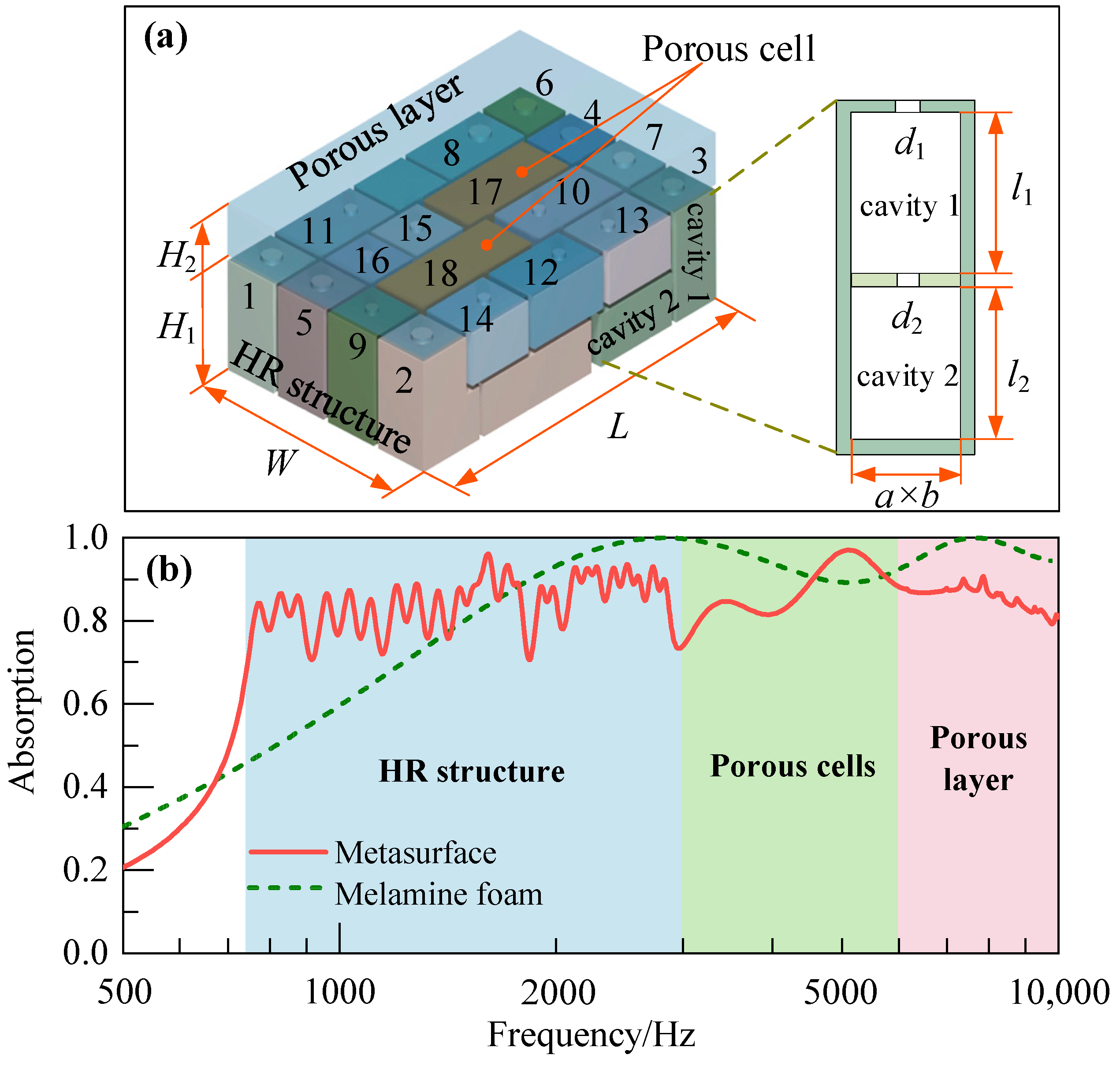
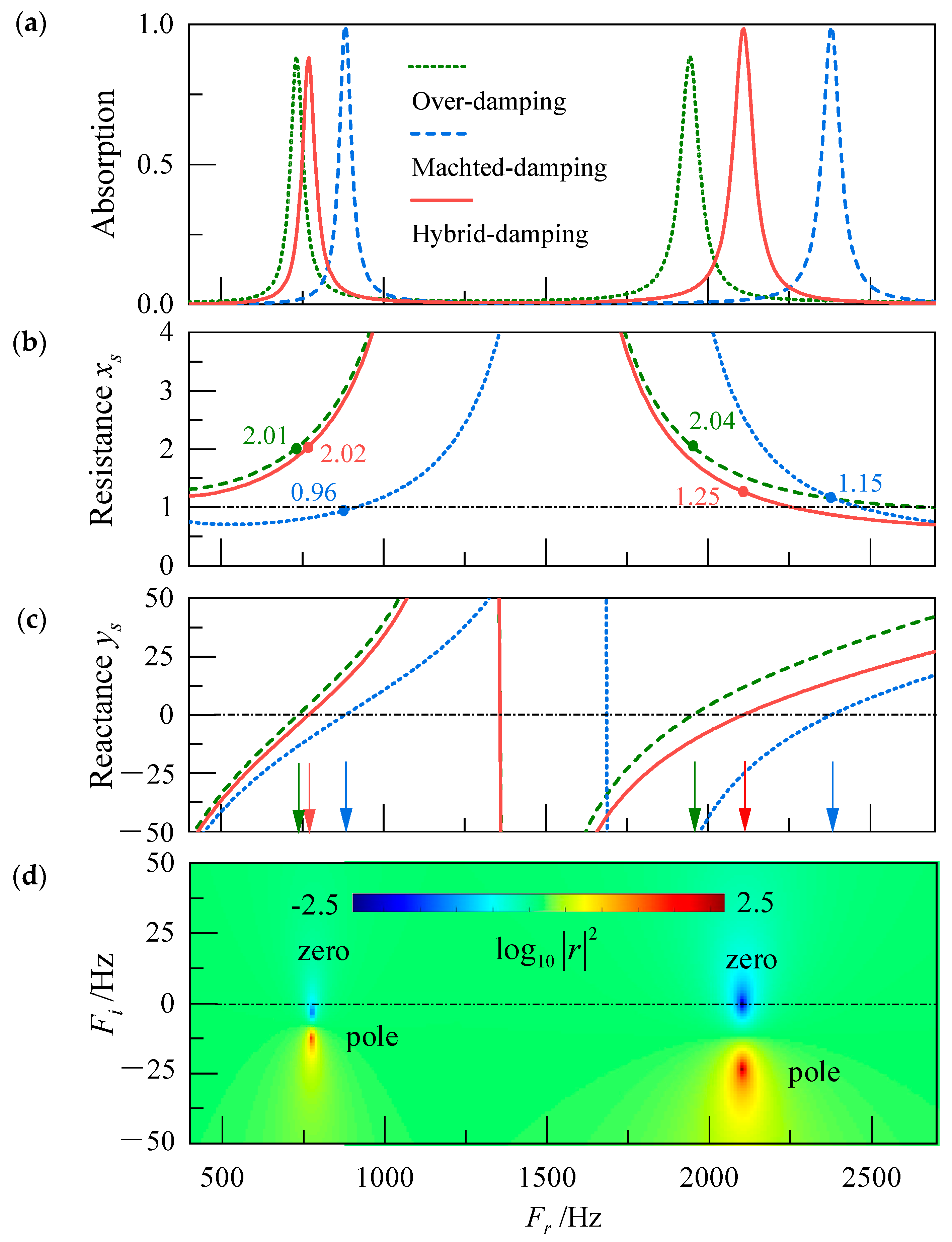

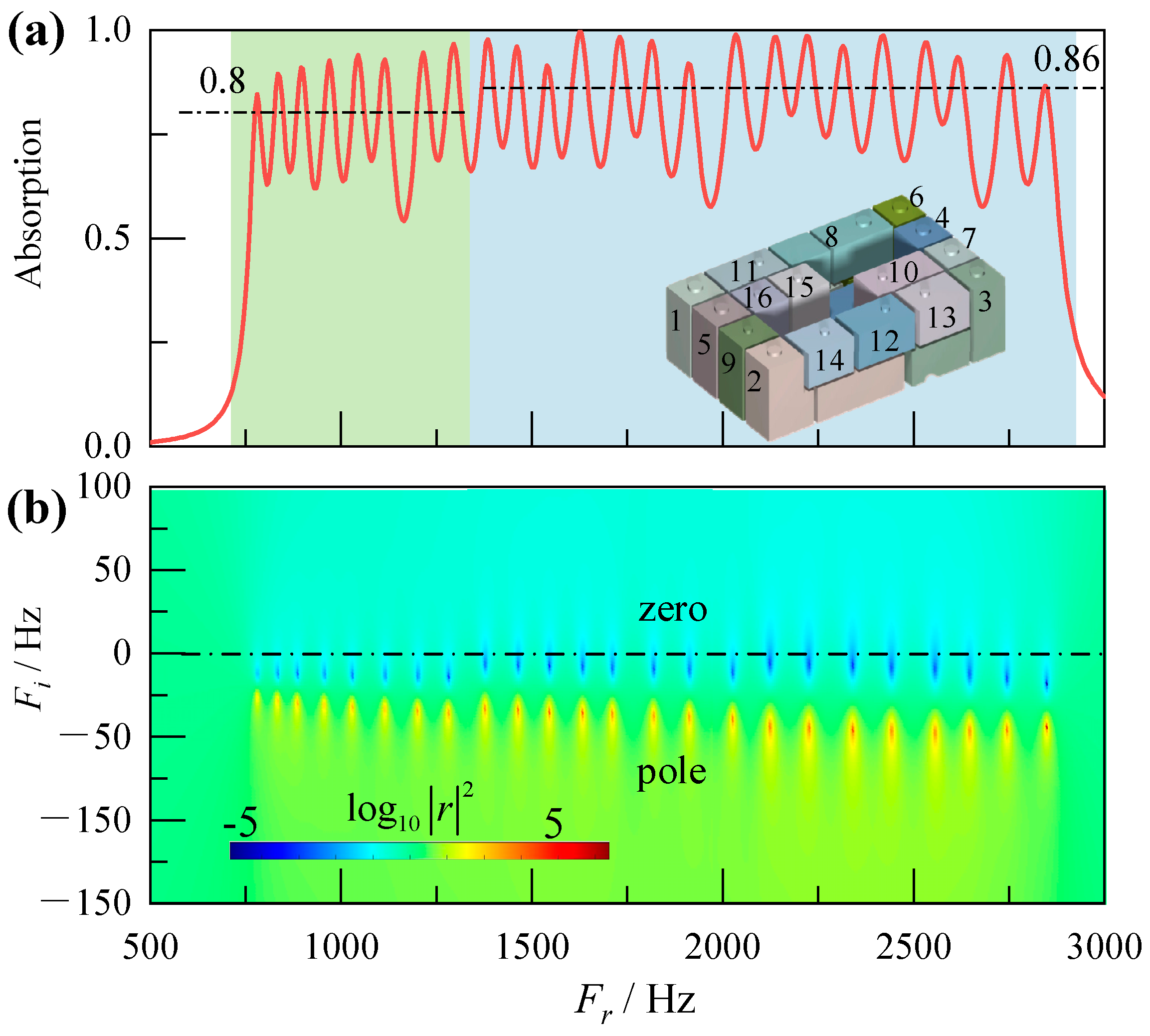


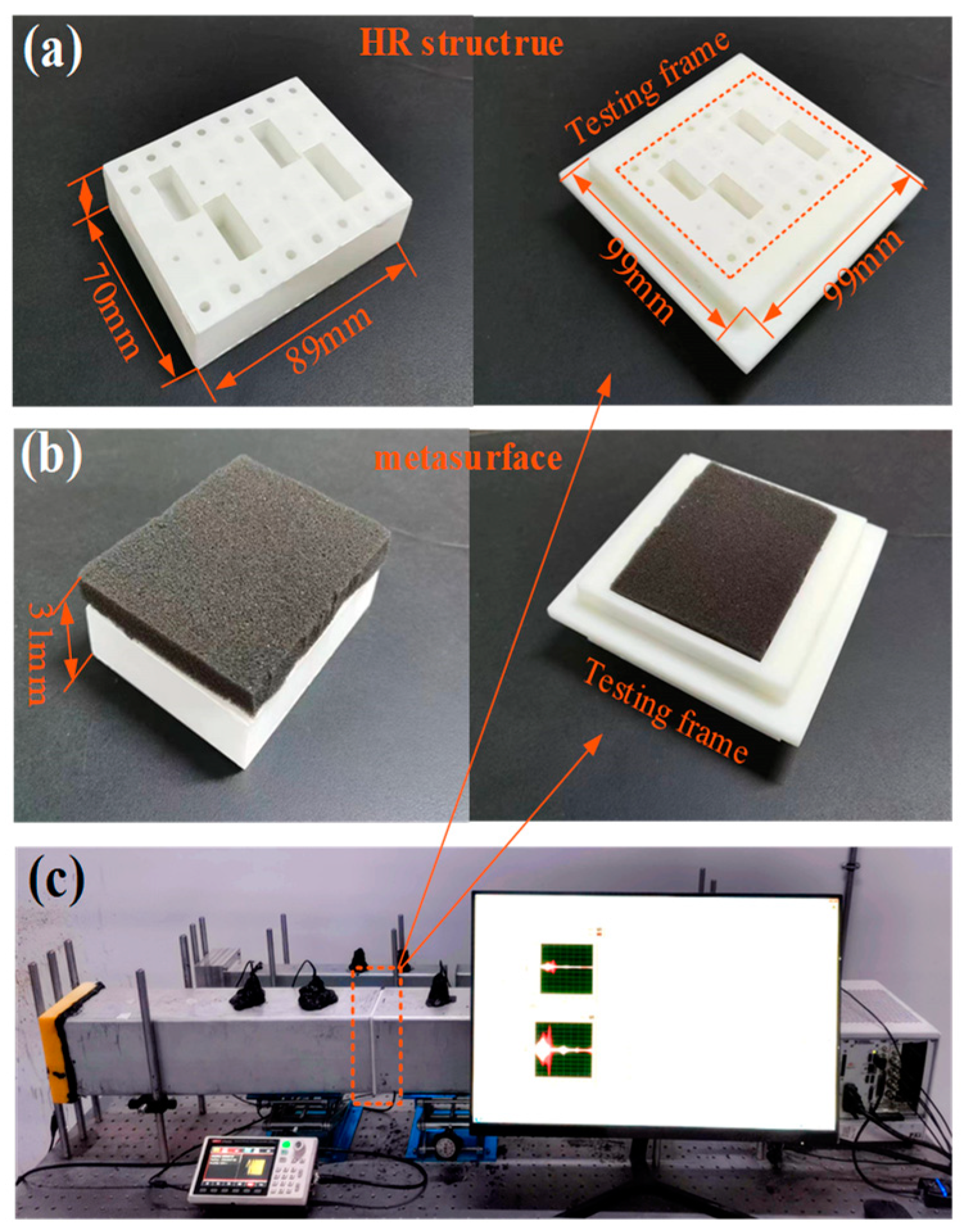
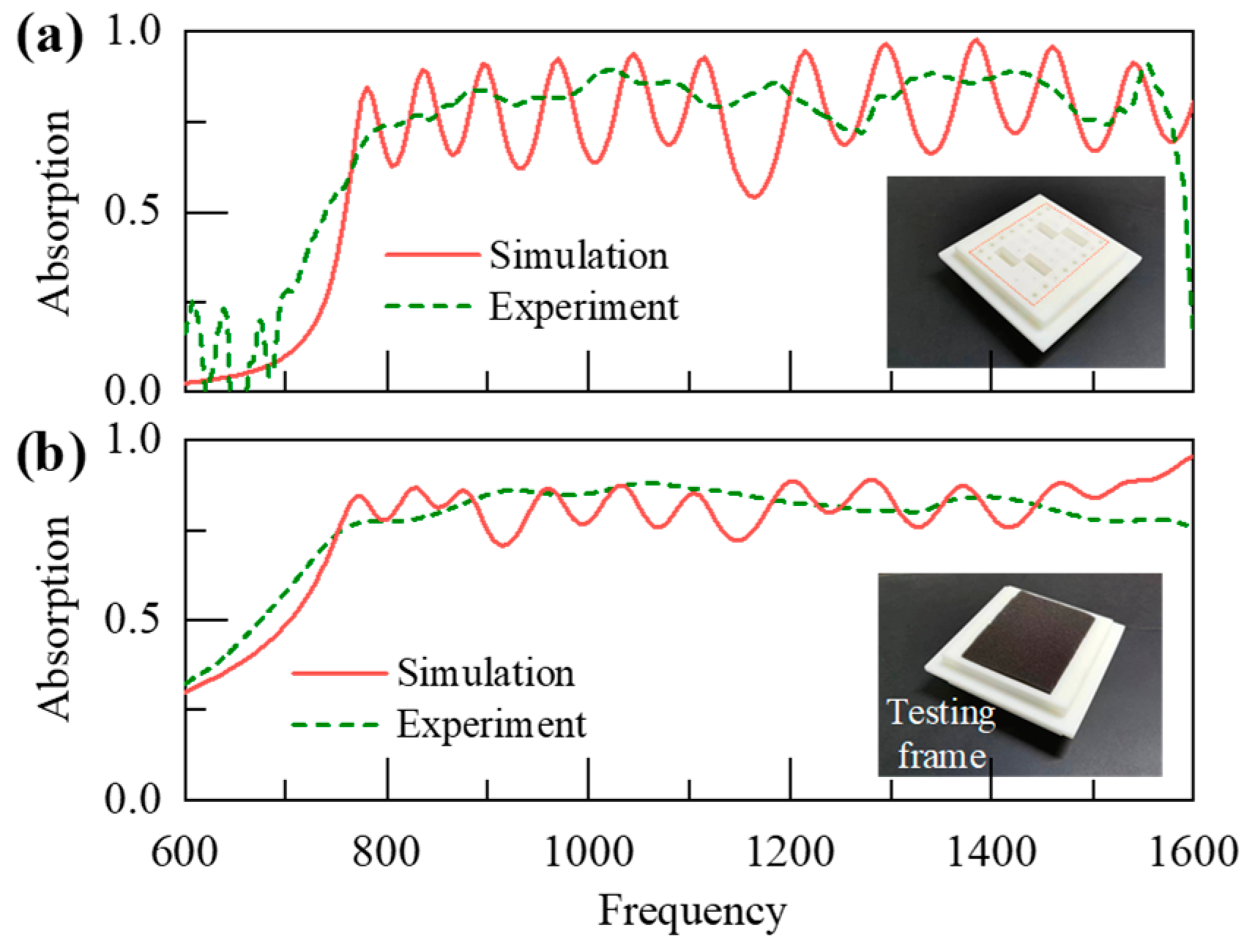
Disclaimer/Publisher’s Note: The statements, opinions and data contained in all publications are solely those of the individual author(s) and contributor(s) and not of MDPI and/or the editor(s). MDPI and/or the editor(s) disclaim responsibility for any injury to people or property resulting from any ideas, methods, instructions or products referred to in the content. |
© 2024 by the authors. Licensee MDPI, Basel, Switzerland. This article is an open access article distributed under the terms and conditions of the Creative Commons Attribution (CC BY) license (https://creativecommons.org/licenses/by/4.0/).
Share and Cite
Liu, C.; Xie, Z.; Liu, X. An Ultra-Thin Composite Metasurface with Hybrid-Damping Modes for Broadband Sound Absorption. Appl. Sci. 2024, 14, 9290. https://doi.org/10.3390/app14209290
Liu C, Xie Z, Liu X. An Ultra-Thin Composite Metasurface with Hybrid-Damping Modes for Broadband Sound Absorption. Applied Sciences. 2024; 14(20):9290. https://doi.org/10.3390/app14209290
Chicago/Turabian StyleLiu, Chongrui, Zexiang Xie, and Xiaoli Liu. 2024. "An Ultra-Thin Composite Metasurface with Hybrid-Damping Modes for Broadband Sound Absorption" Applied Sciences 14, no. 20: 9290. https://doi.org/10.3390/app14209290
APA StyleLiu, C., Xie, Z., & Liu, X. (2024). An Ultra-Thin Composite Metasurface with Hybrid-Damping Modes for Broadband Sound Absorption. Applied Sciences, 14(20), 9290. https://doi.org/10.3390/app14209290





